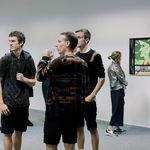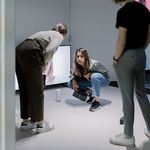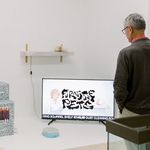Even Still Sexy

Even Still Sexy
UGM Studio, Trg Leona Štuklja 2
12 July – 21 September 2019
artist talk: Friday 12 July 2019, 18:00
opening: Friday, 12 July 2019, 19:00
artists: Dan Adlešič, Zuzanna Czebatul, Jure Kastelic, Botond Keresztesi, Andrej Škufca
curated by: Jure Kirbiš
Even Still Sexy poses the question of what can artists do when the world is on fire. When asked whether his interpretation of Witkiewicz’s 1923 play The Crazy Locomotive was a metaphor for our derailed, crazy world, the famed Slovene theatre director Jernej Lorenci replied: “Yes, but at the same time one can be allowed to be a little sexy amidst this insanity. And to be alive. And to be ingeniously insane. And one can be patulous and loving and full of some kind of imagination. Thus, it is not the haste itself that is problematic; it is the attitude towards said haste which is the problem. All-encompassing paranoia breeds more paranoia. A little esprit, a little laziness, a little idleness, but most of all, a little humour and erotic drive! And this rushing train will no longer be in such a rush, even when going full tilt. We can drop dead twenty years before we actually do, or we can drop dead with at least a chance of a smile on our sorry mugs. And still retaining a little bit of sex appeal. This is the Locomotive, I believe, even if it turns out to be just another train wreck.” In the six years since this delicious quote, the curator has learned to put its sentiment in a theoretical framework of accelerationism. Accelerationism, a social and political theory, decrees that the damaging processes of capitalism cannot be stopped or reversed and must therefore be deepened, enhanced and accelerated in order to destroy themselves. In simpler terms, let the locomotive crash sooner rather than later, so we can deal with the consequences faster. In the meantime, though, let us not despair.
We often look to artists to interpret the world for us, to offer an insight, to fill us with optimism. More so than ever, artists are called to adhere to a standard of social responsibility, to take a political stand, to do what’s right. Some artists resist this notion. Rather than doing what’s right, they’re interested in doing what’s good. What they like. What they find sexy. This can be perceived as a cynical position, one that is own to a certain generation. But it may also be a way to cope. In his book, Learning to Die in the Anthropocene: Reflections on the End of a Civilization, American scholar and writer Roy Scranton in no ambiguous way proposes that we are beyond the point of no return of stopping the self-destruction of our civilization. And as philosophy and by extension art, as one kind of knowledge, have always been a way of addressing one’s own mortality, now that position extends to our existence as a whole. In a way, contemporary art, in its many forms, is a way to mourn our imminent demise. Young artists, faced with the end of the world, therefore can no longer make art that will change the word, but rather make art that will make sense of its ending, at least to them.
The artists in the exhibition are in no uncertain terms informed by the post-internet condition, a praxis in which digital and information technologies are not necessarily the medium itself, but indeed influence the artists’ approach to artmaking. However, the early excitement about the accessibility of information, the democratisation of knowledge and reciprocal global exchange of the world wide web has been replaced by the loss of privacy, constant surveillance, data mining and trading and political microtargeting. The artworks are decadent, ostentatious, fiercely material, as if to resist digitalisation, pixilation, as if wanting to retain their sexiness once the electricity is eventually shut off. Therein lies their resistance. The exhibition borrows the name from the 1968 book Even Still Resistance by Mariborian historian Milica Ostrovška, chronicling the resistance movement in Maribor during WWII. In an exercise of compare and contrast, the curator proposes that at one time, on a local level, there was a clear collective enemy in sight, having only to be defeated. At a different time, on a global level, however, when information is dispersed and tailored to each individual, the enemy need not fear of being identified in the first place. Even Still Sexy joins 5 artists, who, against all odds, despite of everything, face our impending damnation with vigour, spunk and a little bit of sexy.
More about the artists here.



































